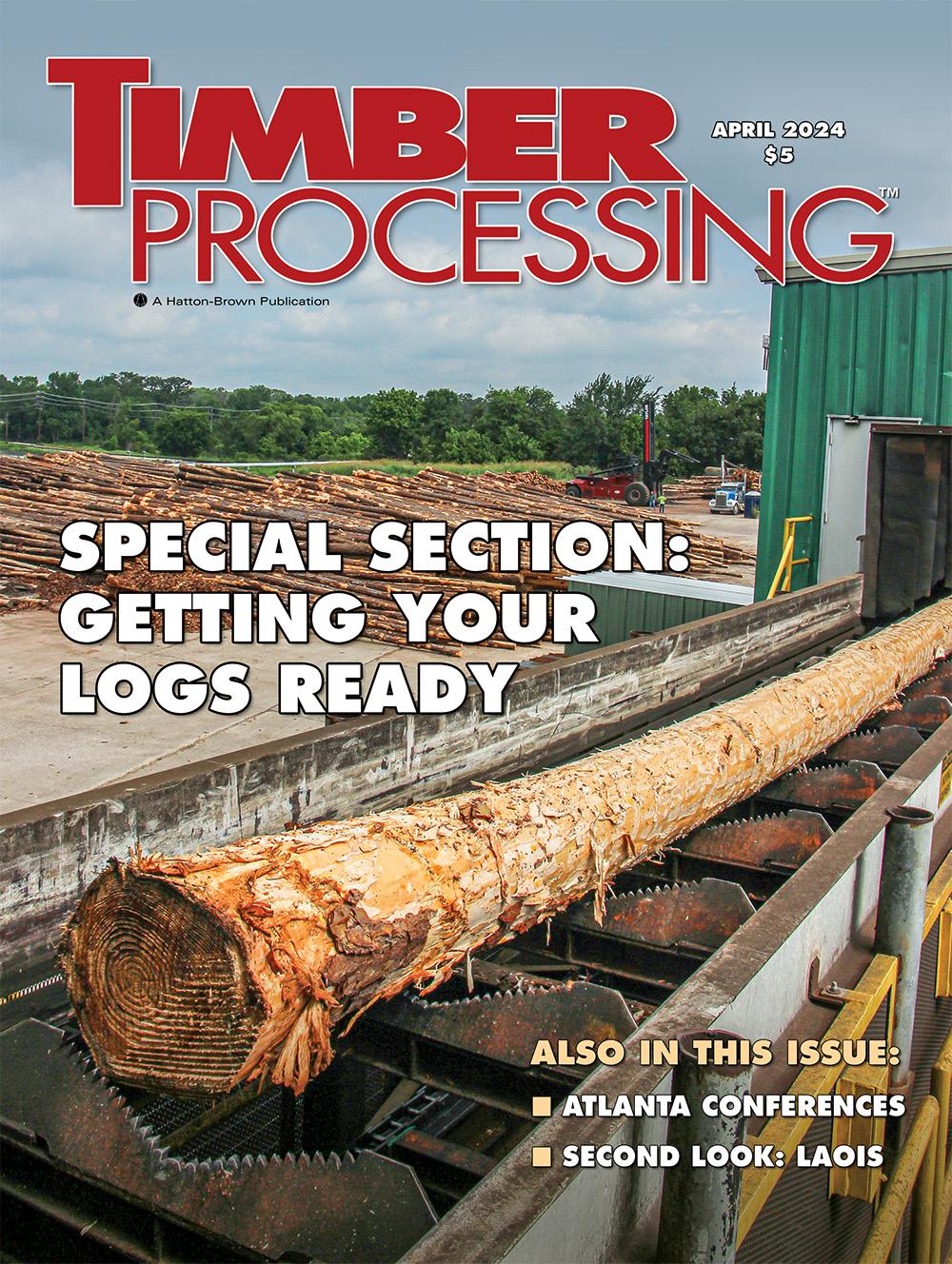April 2024
Cover: Special Section: Getting Your Logs Ready
Don’t get behind the eight-ball from the get-go; that is, make log merchandising a priority.
Inside This Issue
THE ISSUES: Oregon Facing Danger Signs
Financial outlook, log supply and overall operating dynamics for many mills in the Pacific Northwest are taking a turn for the worse, especially in Oregon where the state has embarked on a new regulatory structure expanding no-cut areas on both private and state forest lands.
Article by Dan Shell, Senior Editor, Timber Processing
NEWSfeed
- Hoffman Acquires Besse Forest Products
- Pyramid Mountain Closing Sawmill
Conferences Take Aim
ATLANTA, Georgia — More than 700 wood products industry producers, equipment technology providers, consultants and others participated in the Wood Bioenergy Conference & Expo and the Panel & Engineered Lumber International Conference & Expo—two conferences held back-to-back—at the Omni Atlanta Hotel at Centennial Park in Atlanta, Ga. in mid-March.
Danish Sawmill
When Dansk Træemballage A/S (DTE) looked at how to increase the precision and productivity of its sawmill, one of the major challenges was to establish the right automation control network. As the biggest producer of wooden packaging in Denmark, the plant includes more than 100 inverter drives, all of which needed to be controlled simultaneously and in real-time. The technology used to address this challenge was CC-Link IE, an open gigabit Ethernet designed specifically for industrial automation tasks.
Machinery Row
- Ransford Automates Post-Pointing Line
- Hillmer Andersson Invests in Drying
Find Us On Social
The Issues: Oregon Facing Danger Signs
Article by Dan Shell, Senior Editor, Timber Processing
Financial outlook, log supply and overall operating dynamics for many mills in the Pacific Northwest are taking a turn for the worse, especially in Oregon where the state has embarked on a new regulatory structure expanding no-cut areas on both private and state forest lands.
The state may be the top U.S. lumber producer right now, but log supply in Oregon the past 30 years or so has been an uneasy balance of private, federal (Forest Service and Bureau of Land Management) and state timberlands. Now, with state and private timber owners taking a regulatory harvest reduction, it’s more important than ever for federal officials to meet—and ideally increase—timber harvest levels to help maintain that balance.
Officials with the American Forest Resource Council (AFRC) are sounding the alarm after three mill closures announced in Oregon this year: Hampton Lumber’s Banks mill, Interfor’s Philomath mill, and a two-year sawmill closure announced by Rosboro in Springfield while a new glulam plant is being constructed. In all three cases, the companies involved cited ongoing uncertainty over log supply as contributing to the closure decisions.
Also adding to raw material concerns is the ongoing impact of Oregon’s September 2020 wildfires that burned 971,000 acres of timberland and destroyed 15 billion BF of green timber with more than $30 billion in end-product value, according to an Oregon Forest Resources Institute report.
But perhaps the biggest ongoing 2020 fire impact is the reduction in future timber harvests: between 115-265 million board feet less per year for the next 40 years, according to the report. And almost half the acres burned (46%) were in productive private ownership that’s so important in providing logs directly to mills and to the open log market.
AFRC President Travis Joseph and organization members are urging the Pacific Northwest congressional delegation to take steps to help reverse the trend of more mill closures. This includes more active oversight to ensure the FS and BLM meet and increase timber harvest goals.
Maintaining a healthy and robust forest industry sector is also a key component of addressing federal forest health and wildfire issues. An additional $6 billion outlay to the FS and BLM to increase the pace and scope of forest treatments and stewardship projects hasn’t yielded an uptick in log supply that traditionally accompanies such projects, Joseph says, noting that the BLM’s western Oregon timber sale program this year has been arbitrarily reduced by more than 25%.
The group is also taking the long view on the issue of maintaining a vibrant forest industry sector. The cautionary tale is Arizona, where years of federal forest management neglect allowed forest industry infrastructure to almost disappear. And now, the state is still struggling to develop the timber processing and utilization facilities to make a difference in forest health operations.
There’s also the role of wood building materials and other wood products that sequester carbon permanently and help decarbonization efforts. It’s a sustainable industry that produces sustainable products.
Joseph adds: “If the Federal Government is going to be successful in addressing the current federal forest health and wildfire crises – and protect the extraordinary social, environmental, economic, and cultural values of our public lands – it must sustain and grow the forest infrastructure and related workforces.”
Want More Content?
Timber Processing magazine is delivered 11 times per year to subscribers, who represent sawmill ownership, management and supervisory personnel and corporate executives.
Newsletter
The monthly Timber Processing Industry Newsletter reaches over 4,000 mill owners and supervisors.
Subscribe/Renew
Timber Processing is delivered 10 times per year to subscribers who represent sawmill ownership, management and supervisory personnel and corporate executives. Subscriptions are FREE to qualified individuals.
Advertise
Complete the online form so we can direct you to the appropriate Sales Representative.

